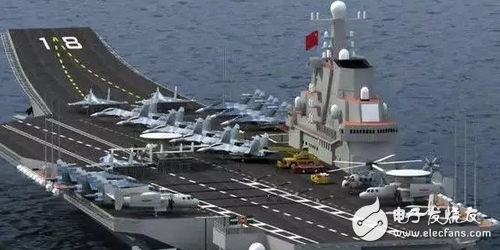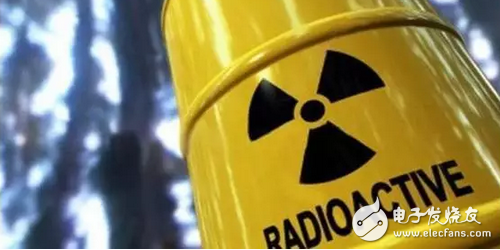With the 001A domestic aircraft carrier's launching and 002 projectile aircraft carrier's arrow on the string, the eyes of domestic military fans are getting higher and higher. China's 120,000-ton nuclear-powered aircraft carrier, the so-called 003, often appears on the Internet and is soon entering the stage of project implementation. But the author is relatively cautious about this.
Military fans want to be in one step, and the mood of catching up with the US aircraft carrier can be understood, but the military is highly technologically engaged in the "Great Leap Forward", and often the speed is not up to speed. While we are seeing the superior technological advantages of nuclear-powered aircraft carriers, we should also have an understanding of the negative effects of nuclear power. It is these negative factors that need to be overcome one by one, which has led to the development of China's nuclear-powered aircraft carrier and requires more time.
At present, more than a dozen aircraft carriers in active service in the United States are nuclear power, and nuclear reactors use weapons-grade highly enriched uranium with high energy density. The latest Ford class does not require replacement of nuclear fuel rods throughout its life, saving a lot of fuel costs, and providing near-infinite endurance for the aircraft carrier during deployment, which is a good aspect of nuclear power.

However, we should also see that the negative effects of the carrier nuclear power are also very large. The main performances are:
First, the size and weight of the carrier nuclear power pack are huge, and most of the weight is consumed on the thick protective shell of the nuclear reactor. The protective shell is mainly composed of lead metal, which is very heavy.
The lower compartment of the Nimitz-class nuclear-powered aircraft carrier is almost completely occupied by the nuclear power system, resulting in an amazing weight of the Nimitz-class aircraft carrier. Looking at the total deck area and the total number of carriers, the Nimitz class is relatively small compared to its own smaller 20,000-ton eagle-class conventional power carrier. In other words, the length and width of the upper flight deck and hangar of the two, Nimitz and the Eagle level are not much different, and the Nimitz level of self-weight and draft is much larger than the Eagles! Nimitz class, "There is too much heavy lead in the belly", the draught is naturally deeper!
Secondly, during the operation of nuclear-powered ships, their nuclear radiation protection is theoretically high, and there is no way to avoid traces or even small amounts of nuclear radiation leakage during operation. This is actually a long-term threat to the health of all ship personnel - the US aircraft carrier will last for half a year. During the first half of the year, thousands of people in the ship had to stay on the ship at all times. In fact, it was equal to thousands of people moving around the two reactors at close range every day. Going to the captain, the pilot, going down to the chef, the big soldier, facing the micro-nuclear radiation, no one can run! On the Nimitz-class aircraft carrier, a large amount of ketchup is reserved, and everyone is required to eat a certain amount of ketchup every meal. Not all Americans love tomato sauce. The truth is: ketchup has certain resistance to micro-radiation. The role requires everyone to eat every meal. Moreover, all the crew members must eat a tablet containing iodine every day, which is also a need for radiation resistance.
All crew members of the Nimitz class aircraft carrier must take a vacation after participating in the mission for half a year. It is no longer necessary to arrange the ship for a certain period of time. This is also the need to reduce the total dose of radiation. With conventional power carriers, these concerns and injuries do not exist.

Third, nuclear-powered ships must be absolutely reliable and have a complete plan for full-life disposal. From the beginning of design, we must consider how to dismantle and scrap after many years to come. In addition to the disposal of the reactor, the equipment and pipelines that are in contact with the reactor have strong secondary radiation after several decades of use. During the production and installation, it is necessary to consider the overall disassembly in the future and close the scrap. This radiation-powered core can't be dismantled, it's useless to disassemble, and the radiation hazard will spread even more.
If the nuclear power ship steel plate contaminated by nuclear radiation is returned to the steelmaking, the molten steel of this furnace will have strong radiation! If you build a house with such steel bars, or if you use a steel plate with radiation to produce a car, the consequences will be disastrous!
Nuclear radiation, either physically or chemically, cannot be eliminated - fire, freezing, and even smelting have no change in the half-life of radioactive and radioactive materials. High-radioactive nuclear waste and secondary radioactive auxiliary materials are only sealed and transported to the uninhabited desert underground or caveded, waiting for millions or even hundreds of millions of years before natural decay can reduce the degree of damage. The half-life of uranium 235 producing atomic bombs is 700 million years! It is equal to the uranium 235 that has decayed by 10% from the time the dinosaurs died!
Due to the many problems involved in the safety of nuclear power of ships, it is very difficult to design, construct and operate. As a result, China began to develop nuclear submarines from the 1960s until the end of the last century.
Even though China's current national strength is much stronger than that of the last century, and technology is more developed, the carrier's nuclear power must still be rigorously tested to ensure safety and reliability.
The smaller power reactor used in nuclear submarines is not suitable for use on 100,000 tons of aircraft carriers; while the residential reactor power of land nuclear power plants is tens of kilowatts, the whole system is too large to be on board. Nuclear-powered aircraft carriers are equipped with 2 to 3 reactors, and the total power is 250,000-300,000 kilowatts. Therefore, domestic nuclear-powered aircraft carriers need to design new marine reactors.
A new type of reactor, from design, production, installation, land experimental operation, ship experimental operation, and finally proved absolutely safe and reliable, can be used on the aircraft carrier, a set of processes to go down, at least 15 years!
There are public reports that China will build at least 20 "floating nuclear power plants" in the future. The number of "20 seats" is likely to include future domestic nuclear-powered aircraft carriers!
Before the construction of a nuclear-powered aircraft carrier, it is very likely that China will first build a nuclear-powered icebreaker or floating nuclear power plant of the same power. China will only inspect the Arctic region in the summer, and it will not be able to “move too much†in the Arctic Ocean. Otherwise, it will cause a rebound in the United States and Russia; one or two nuclear power icebreaking vessels are enough. Due to the restrictions of the Antarctic Treaty, nuclear power icebreakers are not allowed to break ice in Antarctica!
At present, nuclear power icebreakers have not been formally established. The “floating nuclear power plant†was officially established in Bohai Heavy Industry in 2014. According to the design of the shipborne reactor from 2014, the project has started for three years, at least three more years, that is, until 2020, it is only possible to see the physical completion of the real floating nuclear power plant. The loading and running operation proves that it is safe and reliable, and the comprehensive performance is up to standard, which takes 3 to 5 years!
After comprehensive calculation, the domestic 120,000-ton nuclear-powered aircraft carrier will not be able to start the assembly of the ship until around 2023; in 2025, the hull will be formed and the nuclear fuel will be piled up; it will be officially in service until 2027, ten years later.
Polymer Cable Tray is a popular choice for a wide range of industrial, commercial, and residential applications, including power generation plants, oil and gas refineries, chemical processing facilities, data centers, hospitals, schools, and office buildings. It is widely used to support, route, and protect electrical cables and wires in a safe and efficient manner.
The main advantage of Polymer Cable Tray is its lightweight and flexible design, which makes it easy to install and maintain. It is available in various sizes, shapes, and configurations to meet the specific needs of different applications. Some of the common types of Polymer Cable Tray include ladder, ventilated, solid bottom, and wire mesh.
Ladder Polymer Cable Tray is characterized by its ladder-like design, which provides a strong and stable support for cables and wires. It is ideal for heavy-duty applications that require high load capacity and maximum cable protection. Ventilated Polymer Cable Tray features a perforated design that allows air to circulate around the cables and wires, preventing heat buildup and reducing the risk of fire.
Solid Bottom Polymer Cable Tray is designed with a solid bottom that provides a secure and stable base for cables and wires. It is commonly used in areas where dust, debris, or moisture may be present. Wire Mesh Polymer Cable Tray is made from wire mesh that offers excellent ventilation and visibility, making it ideal for applications where cable visibility is important.
Polymer Cable Tray,Perforated Cable Trays,Polymer Cable Trays,Ladder Type Cable Trays
Rayhot Technology Group Co.,Ltd , https://www.cnrayhot.com